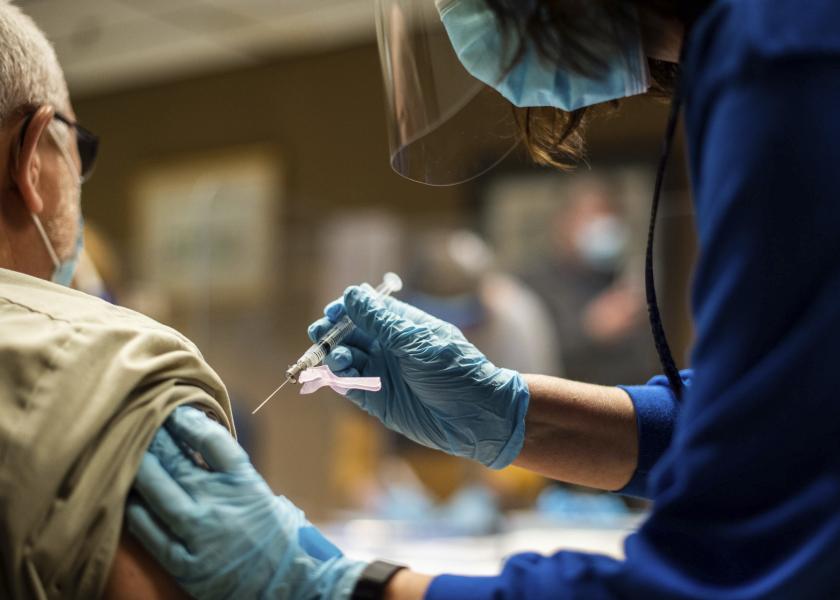Ag Businesses Promote COVID-19 Vaccination, But Not OSHA Mandate

Organizations representing rural businesses say the Biden Administration’s COVID-19 vaccine mandate is not the tool needed to promote more vaccinations and could be damaging to the ag supply chain.
Both the National Council of Farmer Cooperatives and the Agricultural Retailers Association have expressed concern with the OSHA-enforced mandate as a bad fit for their businesses.
“We're all in favor of vaccinations and co-ops have done a lot to promote vaccinations including providing vaccination sites there at the co-op, but having said that, the simple fact is a lot of agribusiness including co-ops operate in areas where at best, there’s maybe 50% vaccination rate,” president & CEO of the National Council of Farmer Cooperatives Chuck Conner told AgriTalk host Chip Flory.
He continued, “Many workers are choosing for a variety of reasons not to be vaccinated. At this point. it's our view that if you haven't been vaccinated, getting vaccinated is probably going to be an uphill climb. And right now, we cannot afford the loss of workers for a critical sector, like food and agriculture.”
Back in September, the Agricultural Retailers Association sent a letter to the Biden administration in light of the mandate’s announcement.
The ARA said it opposed the mandate, “not because we question the vaccine effectiveness, but because it would be counter-productive to encouraging more individuals to receive the COVID-19 vaccine while causing major disruptions for agricultural retailers and other industries already dealing with severe labor shortages, which are impacting supply chains.”
ARA also highlights the mandate does not provide exceptions for employees working from home or who work exclusively outside.
Conner notes the economy is already seeing food price inflation and many NCFC member companies are operating at less than optimum employment levels, which is particularly highlighted by the need for truck drivers who drive solo and are distanced from other employees.
“We cannot afford to lose any more workers without impacting this great food system that we have in this country,” Conner says. “This just needs to be taken into consideration at the Biden administration.”
Conner highlights the announcement of the mandate seemed to even catch OSHA—the enforcing agency off-guard.
“We believe strongly that OSHA was not even aware that this mandate was coming down the pike when it was announced by the White House,” Conner told AgriTalk. “So they were caught pretty flat footed and had to put this together very, very rapidly. I think that's why there's probably a lot of problems with the rule is the haste, and the lack of process that existed in developing it.”
Conner says this should have taken months to develop—not just a few weeks.
“We're back to the point now hoping that somewhere in this process the courts slow this down to a point where we're able to again put people in a room together and actually talk about implications and understand what you're trying to achieve and talk about better ways of doing what you're trying to achieve.”
Hear more from Conner in this AgriTalk interview:
As ARA outlined in a member alert, the COVID-19 Vaccination and Testing Emergency Temporary Standard requires private sector employers with 100 or more employees to do the following 10 things:
- Develop, implement, and enforce a mandatory COVID-19 vaccination policy, with an exception for employers that instead establish, implement, and enforce a policy allowing employees to elect either to get vaccinated or to undergo weekly COVID-19 testing and wear a face covering at the workplace.
- Determine the vaccination status of each employee, obtain acceptable proof of vaccination from vaccinated employees, maintain records of each employee’s vaccination status, and maintain a roster of each employee’s vaccination status.
- Support vaccination by providing employees reasonable time, including up to four hours of paid time, to receive each primary vaccination dose, and reasonable time and paid sick leave to recover from any side effects experienced following each primary vaccination dose.
- Ensure that each employee who is not fully vaccinated is tested for COVID-19 at least weekly (if in the workplace at least once a week) or within 7 days before returning to work (if away from the workplace for a week or longer).
- Require employees to promptly provide notice when they receive a positive COVID-19 test or are diagnosed with COVID-19.
- Immediately remove from the workplace any employee, regardless of vaccination status, who received a positive COVID-19 test or is diagnosed with COVID-19 by a licensed healthcare provider, and keep the employee out of the workplace until return to work criteria are met.
- Ensure that each employee who is not fully vaccinated wears a face covering when indoors or when occupying a vehicle with another person for work purposes, except in certain limited circumstances.
- Provide each employee with information, in a language and at a literacy level the employee understands, about the requirements of the ETS and workplace policies and procedures established to implement the ETS; vaccine efficacy, safety, and the benefits of being vaccinated (by providing the CDC document “Key Things to Know About COVID-19 Vaccines”); protections against retaliation and discrimination; and laws that provide for criminal penalties for knowingly supplying false statements or documentation.
- Report work-related COVID-19 fatalities to OSHA within 8 hours of learning about them, and work-related COVID-19 in-patient hospitalizations within 24 hours of the employer learning about the hospitalization.
- Make certain records available for examination and copying to an employee (and to anyone having written authorized consent of that employee) or an employee representative.







